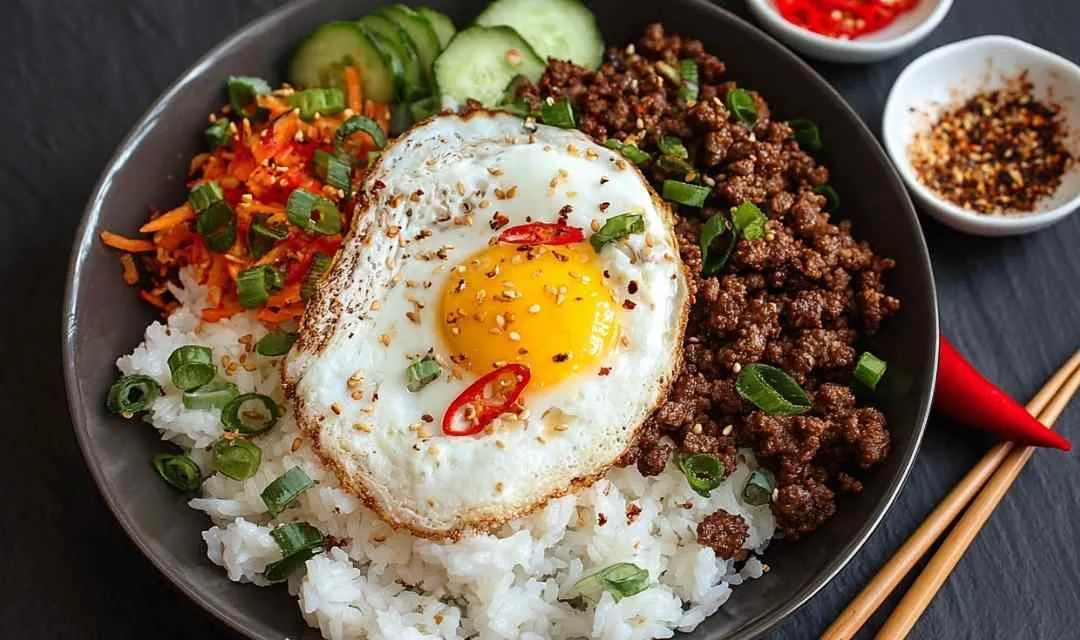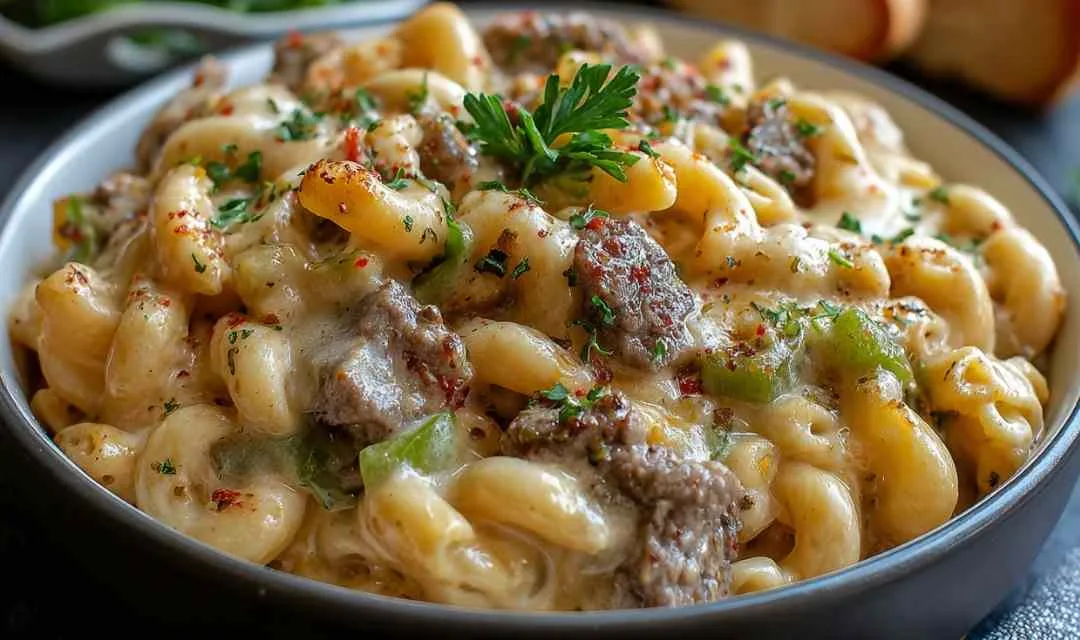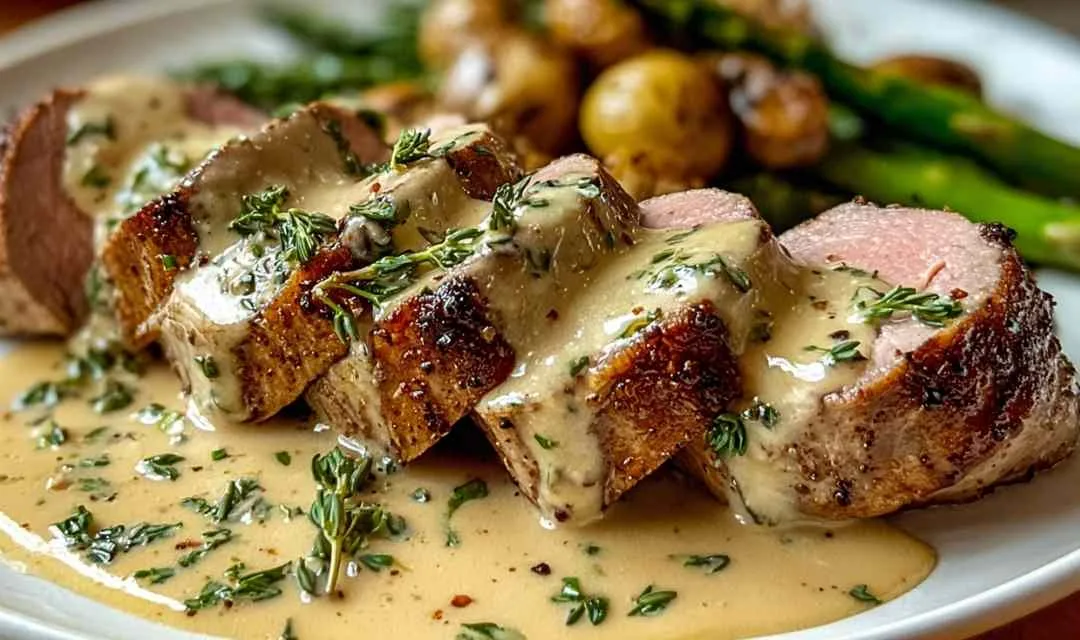High-Protein Korean Beef Bowls bring restaurant-quality Korean flavors straight to your weeknight dinner table without the wait or the mystery ingredients. This simple one-pan wonder delivers serious protein (over 40 grams per serving) and tastes like the kind of takeout you’d drive across town for.
I’ll admit, Korean cooking wasn’t part of my Midwest upbringing, but my youngest grandson introduced me to these bold, balanced flavors during a family dinner last year. The sweet-savory combo of soy sauce and honey, that punch of fresh ginger, the richness of a runny egg yolk… it all came together so beautifully that I knew I had to make my own version. After testing it in my kitchen at least a dozen times, I’ve landed on a recipe that’s quick enough for Tuesday night but special enough that everyone asks for seconds.
The ground beef simmers in a glossy ginger-spiked glaze, getting tucked over warm rice and topped with bright scallions, spicy chilies, and that gorgeous jammy egg. Your kitchen’s about to smell incredible!
What Makes This High-Protein Korean Beef Bowl So Special
This recipe sits right at that sweet spot where nutrition meets pure comfort. I love dishes that work hard for you without requiring fancy techniques or a pantry full of specialty items, and this Korean beef bowl delivers exactly that.
- Packs over 40 grams of protein per serving to keep you satisfied for hours
- Uses simple pantry staples like soy sauce, honey, and rice vinegar you likely already have
- Comes together in under 30 minutes with just one pan to wash
- Adapts easily to your preferences: swap the rice base, adjust the heat level, or meal prep a full week’s worth
- Delivers consistent, crowd-pleasing results every single time you make it
- Perfect for post-workout recovery or anyone watching their macros without sacrificing flavor
There’s something deeply satisfying about a meal that fuels your body properly while tasting this good. No mystery ingredients, no complicated steps, just honest, delicious food.
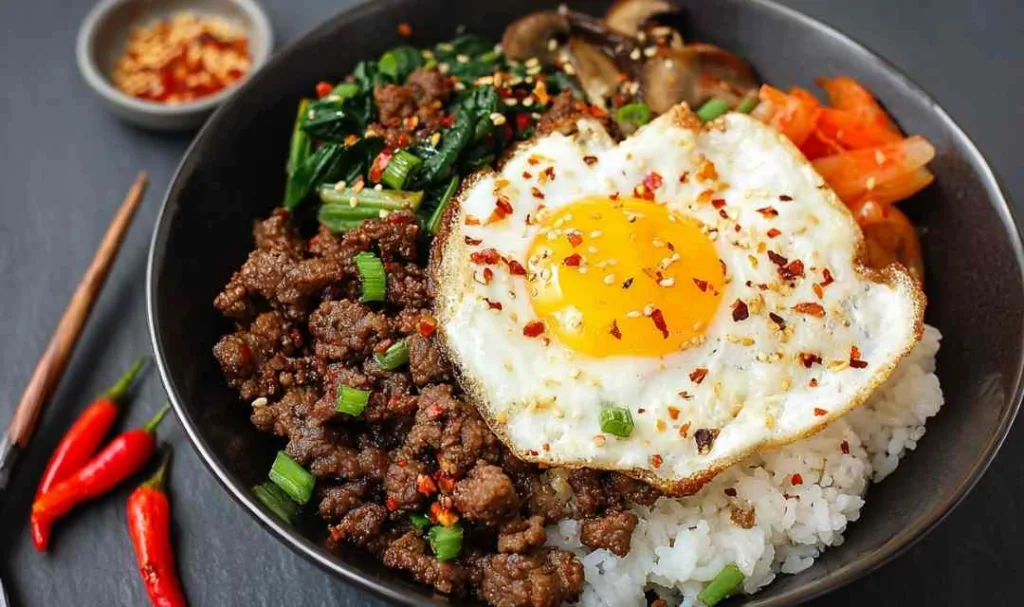
Ingredient Spotlight
Ground beef serves as your protein powerhouse here, delivering that hearty texture and absorbing all those savory-sweet flavors beautifully. I always choose lean ground beef (90/10 or 93/7) to maximize protein while keeping the fat content reasonable, though regular ground beef or ground turkey work wonderfully too.
Soy sauce provides the salty, umami backbone that makes this dish taste authentically Korean. I prefer low-sodium soy sauce in my kitchen so I can control the saltiness better, especially when reducing the sauce.
Honey balances the salty soy with natural sweetness and helps create that gorgeous glossy coating on the beef. The honey also aids in caramelization, giving you those slightly sticky, flavorful bits.
Rice vinegar adds brightness and tang, cutting through the richness of the beef and preventing the sauce from tasting one-dimensional. It’s that secret ingredient that makes people wonder what makes this taste so good.
Fresh ginger gives this High-Protein Korean Beef Bowl its signature depth and warmth. I’ve learned that fresh ginger makes all the difference here; the dried stuff just can’t match that zingy, aromatic quality.
Garlic works alongside the ginger to build that aromatic foundation. I mince mine finely so it distributes evenly and doesn’t overpower the other flavors.
Eggs transform this from a simple beef and rice dish into something truly special. That runny yolk acts like a sauce, enriching every bite when you break it open.
Scallions and fresh chilies provide the final flourish: bright green onion flavor and a customizable kick of heat that makes each bowl feel fresh and vibrant.
How to Make High-Protein Korean Beef Bowls
Step 1. I always start by getting my rice going first; there’s nothing worse than having perfectly cooked beef sitting around waiting for rice to finish. Cook 2 cups of rice according to package directions so it’s hot and ready when your beef is done.
Step 2. Betty’s tip: Heat your skillet over medium heat and add the ground beef, breaking it up with a spatula as it cooks. I’ve found that letting it brown undisturbed for a minute or two before stirring creates better texture and flavor through caramelization, taking about 5-7 minutes total.
Step 3. After years of making this, I learned to drain excess fat if there’s more than a tablespoon or two in the pan; it keeps the sauce from getting greasy and maintains that high protein-to-fat ratio we’re after.
Step 4. Stir in your finely diced onion and minced garlic, cooking for about 2 minutes until fragrant. The key I discovered is not rushing this step; you want the onion softened and the garlic just golden, not burnt.
Step 5. Add the soy sauce, honey, and rice vinegar all at once, stirring everything together thoroughly. I’ve learned that the sauce will look thin at first, but don’t worry… it’ll thicken as it simmers.
Step 6. Let the mixture simmer for 2-3 minutes, stirring occasionally. Through trial and error, I learned that this simmering time is crucial for developing flavor and creating that glossy, slightly thickened coating.
Step 7. While the beef finishes, fry your eggs to your preferred doneness. My family prefers when I make them with runny yolks; they create their own rich sauce when broken.
Step 8. Divide the warm rice among four bowls, then top each with a generous portion of the Korean beef mixture. Betty always starts by making sure each bowl gets equal amounts of that flavorful sauce.
Step 9. Top each bowl with sliced scallions, fresh chilies (as much or as little as you like), and carefully place a fried egg on top. The visual presentation matters; it should look as good as it tastes!
Keeping This High-Protein Korean Beef Bowl Fresh
I typically store the cooked beef separately from the rice and toppings for the best results. The beef mixture will stay fresh in an airtight container in the refrigerator for up to 4 days, making it perfect for meal prep. Let the beef cool to room temperature before sealing the container to avoid excess condensation that can make it watery.
Betty’s freezing method works well for this recipe: portion the cooled beef into freezer-safe containers or bags, and it’ll keep beautifully for up to 2 months. Just leave off the eggs, scallions, and chilies before freezing. I write the date on each container so I know exactly how long it’s been stored.
For the best texture, I reheat the beef gently in a skillet over medium-low heat with a splash of water to refresh the sauce. You can also microwave individual portions for 1-2 minutes, stirring halfway through. Cook fresh rice or reheat refrigerated rice separately, then assemble with fresh toppings and a newly fried egg for that just-made quality.

Perfect Partners for High-Protein Korean Beef Bowls
Cucumber salad with rice vinegar and sesame oil provides cool, crisp contrast to the warm, savory beef. The refreshing crunch balances the rich egg yolk beautifully, and the acidity cuts through the sweetness of the glaze.
Simple steamed broccoli or bok choy adds vegetables to your plate without competing with the bold Korean flavors. I often toss mine with a tiny drizzle of sesame oil and a sprinkle of sesame seeds. Looking for more ways to use broccoli in hearty meals? Try pairing this bowl with a warming soup on cooler evenings.
Kimchi is the traditional Korean accompaniment that brings fermented tang and spicy kick. Even a small spoonful on the side elevates the entire meal and adds beneficial probiotics.
Miso soup makes this feel like a complete restaurant experience. The warm, salty broth complements the beef bowl perfectly and adds extra comfort on chilly evenings. If you’re curious about simple Japanese soups, you’ll love how quickly miso comes together.
Pickled radishes or carrots offer sweet-tart brightness that cleanses your palate between bites. They’re easy to make ahead and keep in the fridge for quick weeknight additions.
Edamame with sea salt works as a protein-rich side that keeps the meal light while adding even more nutrition. Kids especially love these; they’re fun to eat and naturally delicious. For another protein-packed option, consider making taco soup earlier in the week for variety.
FAQs
Can I use ground turkey instead of ground beef? I recommend ground turkey as an excellent substitute that keeps the protein high while reducing fat even further. Just add a teaspoon of oil to the pan since turkey is leaner, and you might want to increase the garlic and ginger slightly since turkey has a milder flavor.
What’s the best way to get a runny egg yolk? To prevent overcooking, I cook my eggs over medium-low heat with a lid on the pan for about 3-4 minutes. The whites should be completely set while the yolk stays soft and jammy, perfect for mixing into your High-Protein Korean Beef Bowl.
Can I make this recipe ahead for meal prep? Many home cooks find success with making a double batch of the beef on Sunday and storing it in individual containers. Keep the rice, eggs, and fresh toppings separate, then assemble fresh bowls throughout the week for grab-and-go lunches.
How can I make this low-carb? Betty’s solution is swapping regular rice for cauliflower rice, which saves about 30 grams of carbs per serving. The Korean beef mixture works beautifully over cauliflower rice, zucchini noodles, or even a bed of mixed greens.
What if I don’t have rice vinegar? The best approach I’ve tested is using apple cider vinegar or white wine vinegar in the same amount. The flavor will be slightly different but still delicious; just avoid distilled white vinegar, which can taste too harsh.
Can I adjust the spice level? I recommend starting with just a small amount of fresh chilies or leaving them off entirely if you’re heat-sensitive. You can always add gochugaru (Korean red pepper flakes) or sriracha on the side for those who want extra kick without making the whole batch spicy.
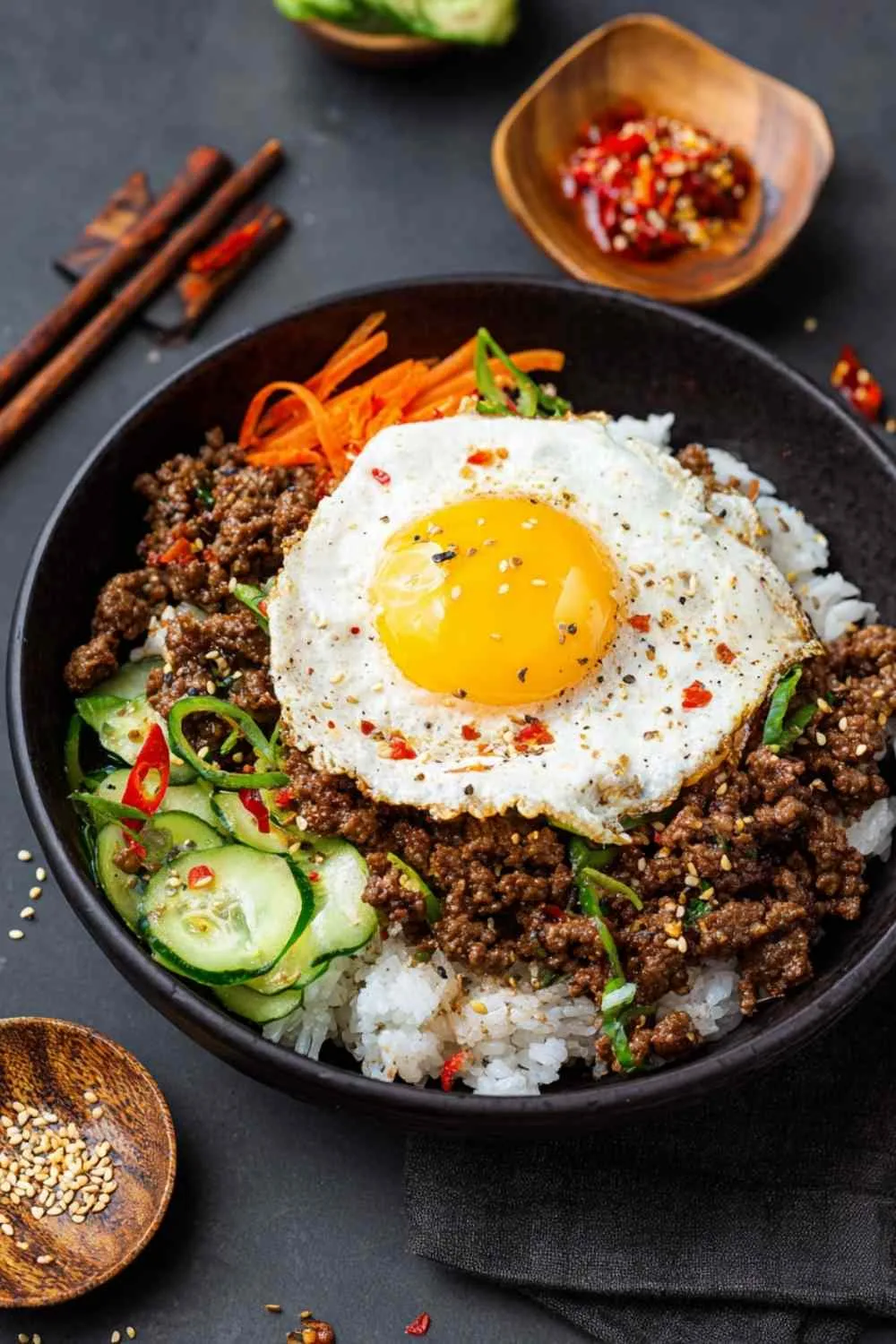
High-Protein Korean Beef Bowl
Ingredients
Equipment
Method
- Cook your rice first according to package directions so it’s ready when the beef is done.
- In a large skillet over medium heat, cook the ground beef, breaking it up with a spatula as it cooks. Let it brown undisturbed for a minute or two before stirring for better texture and caramelization, about 5-7 minutes total.
- Drain excess fat from the pan if there’s more than a tablespoon or two.
- Add the finely diced onion and minced garlic to the beef, cooking for about 2 minutes until fragrant and the onion is softened.
- Stir in the soy sauce, honey, and rice vinegar. Mix well and let the mixture simmer for 2-3 minutes until slightly thickened and glossy, stirring occasionally.
- While the beef finishes simmering, fry the eggs in a separate pan over medium-low heat until the whites are set but the yolks remain runny, about 3-4 minutes.
- Divide the warm rice among four bowls, then top each with a generous portion of the Korean beef mixture.
- Top each bowl with sliced scallions, fresh chilies (adjust to your heat preference), and carefully place a fried egg on top.
- Serve immediately and break the egg yolk to create a rich sauce throughout the bowl.
